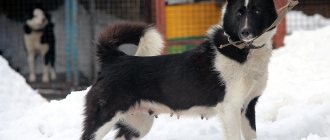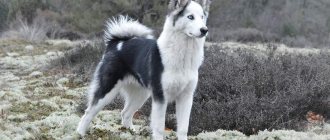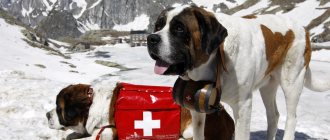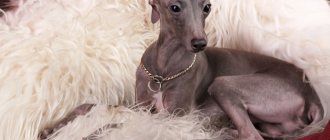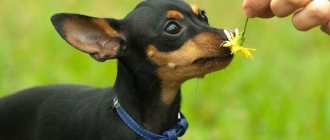- Pets
- >>
- Dog breeds
* Here is a photo of a typical representative of the Samoyed dog breed . You can send us photos of your animals by email, and we will post them on the website. Don't forget to send your pet's name.
Other breed names:
Samoyed, Samoyed Husky, Samoyed Spitz, Sammi
Video
* We invite you to watch a video about the Samoyed dog . In fact, in front of you is a playlist in which you can select and watch any of 20 videos about a given dog breed by simply clicking on the button in the upper right corner of the window. In addition, the material contains quite a lot of photos. By looking at them you can find out what a Samoyed dog looks like.
In this article:
|
Rate the material!
[Total votes: 1 Average: 5]
The Samoyed dog is a beautiful and cheerful animal. They are suitable for completely different people: from married couples to single people who want to have a friendly and affectionate companion. Samoyeds are highly trainable and very sensitive towards their owners, other people and even foreign animals.
History of the origin of Samoyed dogs
The history of the origin of Samoyed dogs is not known with certainty. Even regarding their name, there is disagreement. According to the first version, the name of the dogs comes from a similar name of the people who became the progenitors of the modern Nenets. Samoyed, in this case, comes from the word “samoyed”, that is, “self-centered”, fixated on oneself. This can be justified by the territorial isolation of the Nenets people.
Another name is literal, that is, literally “it goes by itself.” Samoyeds, indeed, were used as sled dogs, which independently rolled sleds and unquestioningly obeyed their owner. There is a version that the snow-white dogs were not visible in the snow, so it seemed that the team drawn by the Samoyeds was driving itself.
There is another option about the origin of the name Samoyeds - “saam-jedna”, which literally means “land of the Sami people”. Samoyeds are dogs bred by the Nenets people for their needs. Smart dogs had to carry sleighs, loads, provide warmth in cold weather, protect herds of deer and follow people.
According to one version, Samoyeds were brought to Europe by the Englishman Joseph Wiggens, who was involved in trade relations with Siberia, although this fact has not been confirmed by experts. The history of the Samoyed breed goes back centuries, so it is very difficult to reliably establish the origin of the breed, and there is almost no evidence of its existence over time.
Another version says that the dogs came to England in 1889 thanks to Ernest Scott, who organized a nursery for the strange breed. Thanks to their qualities, Samoyeds began to gain popularity in Europe. Even King Edward the Seventh had Samoyed Laikas who occupied a privileged position.
In 1920, the first Samoyed association in England was organized, thereby establishing breed standards. Much later, the dogs came to the USSR - only by 1989 were they exported from Denmark. Today, Samoyeds are one of the most popular dog breeds that have spread throughout the world.
History of the origin of the breed
For 3 millennia, this breed played a very important role in the life of the northern tribes representing the Samoyed group. Therefore, for the first time, this breed became known from sources written in the Samoyed language.
Interesting information! Since the northern tribes and nationalities had mostly the same type of dog breeds, experts suggest that the ancestors of this breed are polar wolves, which man managed to tame at one time.
Samoyed dogs are an indigenous breed, so their appearance is more reminiscent of polar wolves, although over the millennia the wild prototype has changed significantly. During the Neolithic period, Samoyeds were used as a hunting dog, and in addition, this breed took part in herding various animals, including reindeer. Moreover, dogs served as a means of transportation in such harsh conditions.
There was a period when it was believed that the Nenets tribes contained aboriginal Laikas, which can be equated to the ancestors of modern Samoyeds. At a certain period of time, many believed that Samoyed huskies were “show class” dogs that were artificially bred by experienced breeders. In fact, many believe that there is no evidence to support these assumptions.
Despite this, the original exterior of the breed quite predictably conquered the whole world. These “snow-white bears” have practically conquered the entire globe, including ordinary dog breeders. At the initial stages, puppies of this breed were highly valued, so they were not available to a large circle of people who wanted them. As a result, quite a lot of these animals were obtained.
Nowadays, we can state the fact that only seven legally recognized breed standards are described, although in order to take part in all kinds of international exhibition shows, one should be guided by the fact that the breed is described according to the AKC classification. Therefore, it should be noted that puppies that are accompanied by documents in English enjoy a special status.
Samoyed dog - description of the breed
The Samoyed husky has two breed varieties: bear and wolf. They differ in minor constitutional parameters. The wolf Samoyed is more elongated and lighter, with a narrow head and a long body. The bear subtype has a shorter, powerful body and a shorter and flatter head.
Interesting fact: The breed standard was described back in 1988 by the English Kennel Club. Adult male Samoyeds should weigh between 25 and 30 kg, while adult females weigh less, between 17 and 23 kg. Height at the withers is 53-55 cm. The length of the body should not exceed the height of the dog by more than 5 percent, that is, the dog is almost “square”.
The Samoyed Laika's skull is wedge-shaped, quite powerful and dense. There is a large distance between the ears with smooth short hair. The muzzle is short, tapering towards the nose. Samoyeds have clearly defined black lips that form a smile. The eyes are almond-shaped, set wide apart, have a black rim, and slightly pointed at the corners. The nose of the Samoyed husky is black, the lobe is developed. Sometimes the nose can be pink-red or brown, but a black outline is required.
The Samoyed's ears are of medium length, slightly rounded at the end, covered with thick hair inside and out, and always erect. A scissor bite is required for this breed. The neck is strong, short, and has a slight bend.
The Samoyed has a strong, straight back, which is slightly longer in females than in males. The loin is pronounced, muscular, the pelvis is strong and slightly inclined. Wide and deep chest. The front legs are of medium length, set at the edges of the chest, the toes pressed tightly together. The hind legs are slightly laid back, very strong and muscular, set parallel to each other. The tail is long and very fluffy; when the dog is in a good mood, it curls slightly over the back or to the side.
Popular colors of Samoyed dogs
The wool of Samoyed huskies is unique in its kind. This is an arctic, thick and fluffy fur designed for very low temperatures. The Samoyed's undercoat is thick, more like goose down. The center coat is long, straight, but soft. Around the neck and over the shoulders there is a wide fluffy collar that forms a ring.
The dog's head and paws are covered with even, slightly shorter hair. It is very soft and smooth, in contrast to the rougher cover of the body. The hind legs, particularly the thighs, are covered with a fluffy layer that resembles pants. Even between the fingers, which are pressed tightly together, there is dense fur.
The color of Samoyeds, at first glance, is very monotonous - white. In fact, dog experts recognize several colors of Samoyeds, which are almost impossible to distinguish from each other with the naked eye.
Namely, these are the colors:
- Matte white. This is a white textured wool without shimmer;
- Glossy white. The fur is more hollow, which is why the fur shimmers in the sun;
- White with a blue tint. Cooler shade;
- White with a red tint. In the light, the dog resembles a small light;
- Light fawn color - a barely noticeable red tint of the Samoyed.
Many dog hairs have a silvery tint to them, which gives the dog a slightly sparkly appearance. This color is due to the living conditions of Samoyed dogs - harsh Arctic regions, where they blended with the snow and let sunlight through them.
Character and habits of Samoyed dogs
Samoyed huskies are very friendly and affectionate dogs that have an affable, easy-going character. They are good emotional companions, fit easily into families and quickly gain popularity. They are ready to communicate, quickly find a common language with people and behave very delicately. At the same time, they do not impose their attention, although they can become depressed if there is not enough communication with them.
Samoyeds are kind not only to family members, but also to everyone around them. They are ready to get to know other people and animals, never show unreasonable aggression, are open to communication and friendly. If its owner is constantly busy, then the Samoyed will look for friends on his own - a strong pack instinct prompts him to do this.
Samoyeds are easy to train because they are quite intelligent and do not have the stubbornness associated with some dog breeds. It is extremely rare for dogs to show willfulness - in this case, a qualified trainer will find an approach to them.
Interesting fact: Samoyeds are very active because they have the hunting instinct. This makes Samoyed huskies playful animals that are ready to run a lot and “hunt” for impromptu prey. Thanks to these character traits, Samoyeds get along well with children - they will never bite or offend a child, and if they don’t like something, they will simply try to get away from the irritant.
Samoyeds can be watchdogs, but you should not have one for this purpose. First of all, these are companion dogs that are aimed at communicating with people and accompanying a person emotionally, and not at any practical activities.
Attitude towards pets and children
Samoyed huskies are very sociable and playful, they are genetically endowed with the habit and love of teamwork, so they get along with other animals without problems and are absolutely not inclined to start conflicts.
Thanks to their optimism, playfulness and curiosity, representatives of this breed get along well with children. They enjoy spending time with them and playing, becoming excellent nannies for babies.
Important! Families with children under 6-7 years old should not get these pets - dogs are prone to barking and howling, which can frighten a child.
Interesting facts about Samoyed dogs
The Samoyed dog breed has been used for a variety of purposes. Transporting cargo and sleds is just one of the many tasks Samoyeds face. For example, Samoyeds were used to hunt both small game and large animals. They hunted walruses and even polar bears.
Samoyeds are good with children for a reason. For centuries, these dogs kept children warm with their warm fur and fussed with them when their parents had no time for it. In fact, Samoyed huskies served as “nannies.”
Due to the fact that people often slept with Samoyed huskies, they have a number of characteristics if a person takes them to sleep in his bed. For example, dogs lie motionless and are afraid to wake a person, and if they are going to leave or roll over, they do it very carefully.
Warm clothes can be made from Samoyed wool - mittens, hats, scarves and socks. This wool provides excellent warmth in winter. In this case, the hair does not need to be cut - it can be easily combed from the dog. Thanks to the peculiarities of the structure of the muzzle, Samoyed dogs always seem to smile. This makes the breed even more popular among breeders.
Samoyed dogs love to bark with or without reason. They bark, howl and squeal especially often when they lack attention - this makes Samoyeds one of the noisiest breeds. This behavior is justified by the fact that in the conditions of the far north, dogs regularly talk to each other using their voices - sound contractions have a warming effect on them.
It may seem that the Samoyed's coat requires a lot of care, daily washing and combing several times a day. Indeed, you need to take care of it carefully, but the structure of the Samoyed’s hair allows the coat to clean itself, and it repels most dirt.
Care and maintenance
The luxurious white coat of a Samoyed can bring a lot of unpleasant moments if you care for it rarely and irregularly. A dog's love for brushing will make life much easier. Teach your puppy to brush himself about once a week from early childhood and accompany the process with positive reinforcement so that the puppy associates it with pleasure. A Samoyed does not require a haircut, but sometimes show dogs undergo grooming to highlight their strengths and hide body flaws.
If you are not going to show your dog, washing it a couple of times a year is enough. Exhibition specimens are washed with special shampoos before each exhibition. You can wash off dirt from your paws and belly after each walk. On particularly dirty autumn and spring days, wear a waterproof mudguard on your Samoyed to keep his coat clean.
An indispensable assistant in the care and maintenance of a Samoyed will be a compressor and a grooming table. The compressor dries the fur several times faster than a hair dryer, without drying out the skin and fur of the animal. Your back will thank you for the grooming table; Plus, it has been noticed that dogs behave more quietly on the table.
During shedding, you need to brush your long-haired Samoyed more often than usual. You can blow dry hair with a compressor - a stream of air blows out fallen hairs and dead skin particles, massages the skin, improving blood circulation.
The dog's coat perfectly regulates temperature not only in the cold, but also in the heat. Therefore, if you shave or trim your pet's thick coat, he is more likely to suffer from overheating than from being covered in fur.
Teeth are brushed once a week, ears are sometimes wiped with a dry cloth. Samoyeds' claws usually wear down on their own if you walk them enough.
Walks should be quite long, at least an hour and at least twice a day. It is better to spend this time actively and variedly - running, playing, doing a little training. A well-walked Samoyed will calmly take its place on the bedding and will not cause damage to the house.
Pros and cons of Samoyed dogs
Like any other dog, Samoyeds have their pros and cons that should be considered before getting a puppy of this breed.
The advantages of the Samoyed Laika include:
- Patience. Dogs are calm about children's games, even if a child pulls them by the tail and ears. Samoyeds are similarly patient with other animals who want to play with them. And if a medium-sized dog treats the Samoyed with aggression, the Samoyed Laika will prefer to gently ignore the bully;
- Communication skills. Samoyed huskies easily get along with other animals, make contact with people, are always ready to be near a person and enjoy communication;
- Calm character. Despite their sociability, Samoyeds are not hyperactive, but calm and measured;
- Samoyeds do not need special food - they are quite unpretentious in food;
- Samoyeds have strong immunity. They tolerate low temperatures especially well and can even live outside, rather than in a house or apartment.
The disadvantages of the Samoyed Laika include:
- These dogs need coat care more than any other. Samoyeds need to be washed and combed with special brushes, and also trimmed regularly;
- Samoyed dogs are very noisy. They love to bark, howl, squeal and make other sounds. Even during normal human interaction, they can communicate with their voices rather than with gestural signals, as many other dogs do;
- Samoyed huskies are bad guards - because of their friendliness, they can let strangers get very close. Likewise, they will not defend the owner by rushing at offenders;
- Samoyed Laika puppies are quite expensive.
History of the Samoyed dog breed
Samoyed
Researchers believe that Samoyed huskies have been living next to humans for about three thousand years, and in an almost unchanged form, since their habitat is limited, and mixing with other dogs was impossible for objective reasons.
The breed got its name from the name of the nomadic tribes of the northern regions of the Urals and Siberia, now known as the Nenets. These peoples lived separately from the surrounding world and were self-sufficient, “self-unified” - hence the name. There is no need to look for any “gastronomic” subtext in the word “Samoyed”.
From these parts, at the end of the 19th century, the British zoologist and dog lover Ernst Kilburn-Scott brought several remarkable dogs to London. Among them was a very large snow-white male named Masti. It was from this period that the modern history of the breed began. In 1909, Scott and his wife opened the still famous Farmingham kennel, and a couple of years later the first club for lovers of unusual northern dogs appeared. At the same time, a standard was defined that has existed unchanged for more than a hundred years. The breed quickly gained wide popularity, and already in the thirties of the last century, nurseries for breeding Samoyeds appeared in continental Europe. Such attention of breeders to preserving the species played a positive role. The fact is that the development of civilization has led to irreversible consequences: even in its original habitat, in the Far North, it is very problematic to meet a purebred Samoyed aborigine. In its original form, the breed was preserved in Western nurseries, from where it began its return to its historical homeland - Russia. Today the number of Samoyeds in our country is 2-3 thousand individuals.
Samoyed puppy with mom >Video: Samoyed
Breeding Samoyed dogs
The female Samoyed husky begins to come into heat at 6-12 months. It occurs twice a year, but the duration is difficult to predict: from 7 to 28 days. All this time, the Samoyed husky can become pregnant. You should skip the first three heats, and after the third heat you can start mating.
There are three stages to the Samoyed husky's heat cycle. In the first few days, she does not accept male dogs, although they show interest in her. At the second stage, she is ready for mating - this is approximately 5-7 days after the start of estrus. In a week, she will again have a negative attitude towards attention from male dogs, and mating will be impossible.
Breeders allow mating of a Samoyed female only when she is at least 18 months old, and males - from 15 months. At this age, dogs can give birth to the most productive and healthy offspring. Since pregnancy is a huge stress for the body and a burden on the immune system and internal organs, only healthy and strong dogs should give birth.
The Samoyed Laika's pregnancy lasts about 63 days. During this time, the dog gains a lot of weight, becomes lazy and inactive. You need to walk it more often so that it does not develop heart problems, but in no case should you overload the dog so that it does not become overworked and stressed.
If the bitch refuses to eat or her body temperature rises, you need to contact a veterinarian. In the second half of pregnancy, slight green or yellow discharge is possible - this indicates that birth is near. A day before giving birth, the dog begins to fuss, whine and bark. Her breathing quickens, she often goes to the toilet, and is constantly thirsty.
Sometimes Samoyeds, like other dogs, experience false pregnancies. This is a situation where the dog has not been impregnated but is acting as if it is pregnant. She may even go into labor, but she will not produce puppies. In case of false pregnancy, you should consult a veterinarian. It is also advisable to entrust childbirth to a veterinarian, although Samoyed huskies are in good health and are quite capable of giving birth on their own.
How to properly care?
The main difficulty in caring for Samoyed huskies is thoroughly brushing their coat. Otherwise, these are nothing more than hygiene procedures necessary to maintain health and an attractive appearance.
Wool and bathing
The coat should be brushed with a slicker brush or a metal brush with long rounded teeth 2-3 times a week, and daily during seasonal shedding. This will help avoid the formation of tangles and get rid of dust and dead hairs.
Shedding lasts 2-3 weeks, once a year in males and twice a year in females.
Reference! When kept indoors, Samoyeds shed throughout the year.
Representatives of this breed should be bathed no more than once a quarter, since their coat is capable of self-cleaning. With more frequent washing, it becomes dull, the skin peels and turns red.
To bathe Samoyeds, you need to use deep-cleansing whitening shampoos, as well as a conditioner or coat mask.
Teeth
To avoid the appearance of plaque and tartar, it is necessary to brush the Samoyed’s teeth weekly with a special brush and toothpaste, and also introduce solid food into the diet.
Eyes
A healthy dog should have shiny eyes with no signs of souring or excessive tearing. To prevent such problems, you should wipe your eyes 1-2 times a week with a soft cloth soaked in boiled water, chamomile infusion or tea leaves.
Ears
Wipe your ears weekly with a damp cotton pad to remove dirt, dust and wax buildup.
Claws
In dogs that lead an active lifestyle, their claws wear down on their own during walks. If this does not happen, then 1-2 times a month they need to be trimmed with a nail clipper for medium breeds, not forgetting about the dewclaws, if any. Sharp edges need to be smoothed with a nail file.
Walk
These dogs need walks at least twice a day for 1-2 hours each. They must be active, include elements of training, running, and outdoor games.
Caring for Samoyed Dogs
Samoyeds are not particularly picky about their living conditions, especially if you buy a dog for a private home. They are able to live outside in an enclosure even in winter - and this option is more comfortable for dogs than living in an apartment. They are perfectly adapted to cold weather, but do not tolerate heat well. In addition, dogs require a lot of space.
If your Samoyed lives in an apartment, follow these guidelines:
- From an early age, the puppy must know its place. Organize a comfortable soft bed that will serve as a bed for the dog;
- The Samoyed should be brushed at least three times a week, preferably every day. For combing, hard brushes with sparse teeth are used, which are capable of combing out the thick undercoat. If you want the top layer of your dog’s coat to look great, you should also use a brush with natural bristles;
- After walks, you need to not only wash your paws, but also treat them with a soft cream - Samoyeds do not tolerate asphalt and hard surfaces very well;
- Ears and teeth should be cleaned, and nails should be trimmed as soon as they begin to click on the floor;
- You shouldn't bathe your Samoyed too often. As a rule, once every two weeks is enough, especially if the dog has not purposefully gotten dirty;
- Samoyeds should not be left alone for long periods of time as they may become depressed;
- The Samoyed should be walked twice every day, the walk should last at least one hour - dogs need to move a lot, play and run.
Although Samoyeds are very fluffy dogs, they do not require as much grooming as, for example, Afghan Hounds. You just need to comb them and wash them with special shampoos and conditioners.
Raising Samoyed dogs
The Samoyed is far from an apartment dweller. These pets need space to express their activity, as well as regular exercise.
Sleigh rides in winter with these dogs can turn into a whole adventure. Not only children, but also any adult can ride with them. A Samoyed can handle it!
And in the warm season, with proper training, such a dog can even drag a wheelbarrow with a couple of buckets of potatoes, and at the same time he himself will enjoy such useful loads.
Their northern origin does not prevent Samoyed dogs from tolerating the warm season and even heat normally, but you should not take these dogs for walks in the direct rays of the sun in the summer.
Photo 6. Samoyed Laika is one of the most wonderful dogs
For summer walks, it is better to choose days when the heat subsides, or in the morning/evening.
Like most other dog breeds, Samoyeds love attention.
If possible and time is available (and even if not), it is recommended to organize walks with elements of training for these dogs so that they include at least light physical exercise.
Communication with Samoyeds helps treat depression and nervous conditions in people. It is worth taking note of this for those who have hard work with psychological stress.
Despite their thick coat (which literally turns Samoyeds into a big white lump in winter), dogs of this breed do not require any specific grooming procedures.
It is not typical for them to have an odor, and with constant brushing, there will be no problems with the hair of these dogs.
Samoyed huskies need to be combed at least a couple of times a week, and washed no more than once every 5-6 months. Rarely? Not at all. The coat of these dogs has the property of self-cleaning, which allows the dog, although not always, to remain clean.
Video about the Samoyed Laika dog breed:
Diet of Samoyed dogs
As is the case with other dog breeds, Samoyeds can be fed homemade food or bought ready-made dry food - this is the choice of the dog owner. In any case, the diet must be balanced and healthy, otherwise the pet risks getting sick.
Only premium food is suitable for Samoyeds. It must be specially formulated for this breed, otherwise you again risk choosing an unbalanced food. If it is not possible to choose food for your breed, then give preference to food for large and active dogs.
To create a menu for a Samoyed yourself, you must consult with a specialist. Homemade food can be both beneficial and detrimental to your four-legged friend. It is necessary to strictly observe the ratio of all products so as not to harm the dog. If the food is chosen incorrectly, the dog becomes less active, his coat becomes dull, he is reluctant to walk and rarely goes to the toilet.
Products that are allowed for Samoyed dogs:
- Beef, chicken and turkey;
- Both sea and ocean fish, but without bones, raw or frozen;
- Suitable dairy products include low-fat kefir, yogurt, cottage cheese, yogurt and fermented baked milk;
- Samoyeds are very fond of vegetables, both raw and boiled;
- You can give simple fruits - apples and pears. Exotic fruits should not be given to Samoyeds. Fruits should not be a daily diet, but rather a reward for behavior or training.
Foods that should not be given to Samoyed dogs:
- They do not digest carrots well, so it is contraindicated for Samoyeds in large quantities;
- Whole milk is also prohibited for Samoyeds;
- Bakery;
- Sweet;
- Pasta;
- Fatty pork, lamb, fresh and steamed veal, boiled bones;
- Beets, potatoes;
- Sugar and salt, various spices;
- Sweets and chocolate.
Character of the Samoyed dog
Smiling dog
If you are looking for a dog with the perfect personality, then the Samoyed is the one for you. Representatives of this breed are surprisingly friendly, playful and smart. However, one cannot call them phlegmatic and quiet. The spirit of enthusiasm, passion for teamwork, the need for constant communication, ebullient energy and, at the same time, surprising, sometimes even excessive trust in others are the main character traits of the Samoyed. To make the portrait of this northern handsome man more objective, it is worth mentioning his stubbornness, which the owners of these dogs associate with an innate sense of self-esteem. The habit of working in a team and living in close contact with other pets, inherent at the genetic level, has practically eliminated the tendency to conflict behavior, although the courage of the Samoyed husky cannot be denied. This character trait is indicative of the breed, and any manifestations of cowardice or aggressiveness are considered a serious fault. For the same reason, you should not count on the Samoyed as a guard dog. Distrust and wariness may be the only behavioral reactions towards a stranger.
The Arctic Spitz Hunter, contrary to his historical past, is also very mediocre. Of course, he won’t refuse to chase the neighbor’s cat up a tree, but he certainly won’t understand or share your passion for hunting. Another thing is active games and competitions. Here his energy is in full swing. Favorite activity: driving. Even the opportunity to simply take your children on a sled will be the best reward for the dog.
The Samoyed is a dog that needs constant contact with its “pack” (and your family is that for it). Loneliness is simply harmful to these beauties. Many owners have noted in their pets even manifestations of such a purely human feeling as fear of impending separation. Keeping a Samoyed husky on a chain or locked in an enclosure is simply inhumane. As a result of such treatment, the animal may develop permanent mental disorders.
Samoyed with his owner What a success!
Samoyed dogs get along well with small children, although they can show their overwhelming feelings with excessive assertiveness. The Samoyed will quickly connect with your child and become a wonderful companion and playmate. Arctic Spitz puppies have a restless, even slightly hooligan character, so they simply need constant attention from their owner.
This breed is not suitable for busy people who are rarely at home. It is unlikely that calm people who prefer a measured course of life will appreciate the benefits of the Samoyed dog, because the animal loves to bark, and to maintain vitality it needs systematic physical activity. But if you decide to get a Samoyed, be prepared for the fact that the rhythm of your life will change dramatically. And who said that this is not for the better?
Samoyed with a child
Diseases and health problems
Samoyed dogs have strong immunity and good health, so diseases can only appear for a number of objective reasons: age, improper care, rare congenital pathologies.
Interesting fact: Most often, dogs suffer from diseases of the endocrine system, namely hypothyroidism, which disrupts the functions of the thyroid gland. Because of this, the metabolism slows down, the animal gains weight, its health gradually worsens, hair falls out, and sensitivity to cold appears. Sometimes females as young as four years old suffer from hypothyroidism.
Diabetes mellitus is also a common disease that is associated with a lack of insulin. Samoyeds begin to drink a lot of water, lose weight, constantly go to the toilet and become hungry. In the later stages, vomiting, weakness begins, and cataracts develop. Most often, older animals suffer from diabetes.
Portosystemic shunt occurs in many large dogs. Blood circulation in the liver is disrupted and harmful substances accumulate in the blood, adversely affecting the dog’s internal organs. In severe cases, the dog gains weight and falls into a coma. Treated only under the supervision of a veterinarian.
Samoyeds also have hip dysplasia, which is inherited and has varying degrees of manifestation. In the worst case, the disease can lead to arthritis. Many northern dog breeds suffer from this disease.
Congenital deafness is sometimes found among Samoyed Laikas. Dogs also often have bloating, which sometimes develops into volvulus. In general, Samoyeds are not difficult to treat; diseases are easily diagnosed and, as a rule, do not develop into severe forms.
Health
Samoyeds are healthy dog breeds, but a lot will depend on the breeders from whom you are going to purchase a Samoyed puppy.
The cost of a dog in kennels, as a rule, is higher than that of amateur breeders, however, the risks associated with the dog’s health and its mental deviations are reduced. On average, Samoyeds live 12-15 years.
- Newfoundland - history of the breed, education, care + 73 photos
Chihuahua - history of the breed, description, temperament, attitude towards people and animals, care + 92 photos
Brussels Griffon - history, modern appearance, standards, character and content + 77 photos
The breed is characterized by a number of diseases that are worth paying attention to, regardless of the choice of manufacturer:
- ophthalmological diseases - cataracts, dysplasia and progressive atrophy of the retina, glaucoma;
- endocrine diseases - hypothyroidism, diabetes;
- cardiovascular diseases – aortic stenosis
- other diseases - arthritis, congenital deafness, hip dysplasia, renal dysplasia, congenital portosystemic shunt.

